
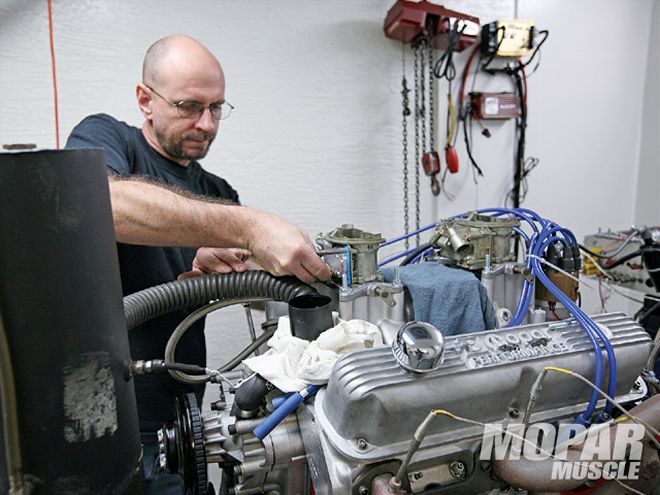
It was late in 1967 when Mopar's 340 first became available in the '68 models. Sure, it may have only been 22 ci larger than its counterpart, the 318, but with performance in mind, the guys at Mopar gave it goodies like a dual-row timing chain, a windage tray, 2.02-inch intake and 1.60-inch exhaust valves, and a high-rise dual plane intake with an AVS carburetor, a steel crankshaft, and high-performance heads. Make no bones about it, the 340 was here to make a statement.
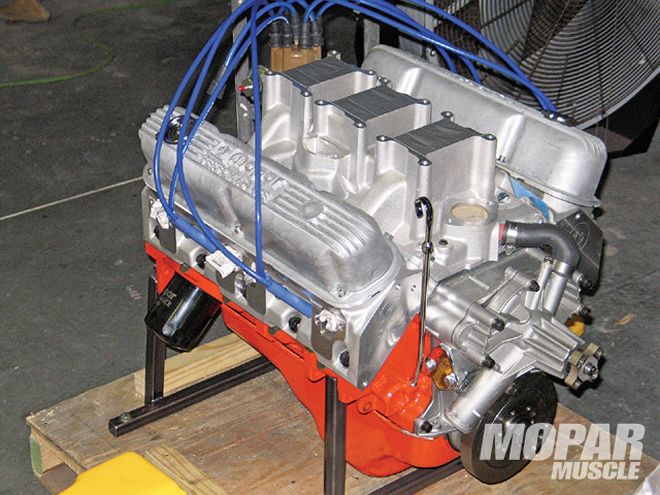 The 340 Six Pack crate engine as delivered. When you get your engine, you'll need to get carburetors, linkage, fuel lines, and a neutral balance flywheel. Other than that, it's ready to rock.
The 340 Six Pack crate engine as delivered. When you get your engine, you'll need to get carburetors, linkage, fuel lines, and a neutral balance flywheel. Other than that, it's ready to rock.
Throughout its life, the 340 was treated to different options and changes. Some maybe not considered performance oriented; a cast-iron crankshaft was utilized starting in 1973. And as for induction, everything from an 850-cfm Thermoquad, all the way up to a Six Pack (Six Barrel for you Plymouth guys), rested on top of the "high performance" heads of the 340.
But we know you guys know all this stuff, so why are we telling you this? Because it's 2009, and some of it may have been forgotten, and would you believe you can now buy an all-new 340 Six Pack directly from Mopar? That's right, Mopar has brought back the 340, and it does its heritage proud. At its peak, the venerable '70 340 boasted 290 hp--this in its Six Pack livery. Now, however, the new 340 Six Pack is rated from Mopar to reach 330 hp, and 330 lb/ft of torque--we prove them wrong, and more on that later.
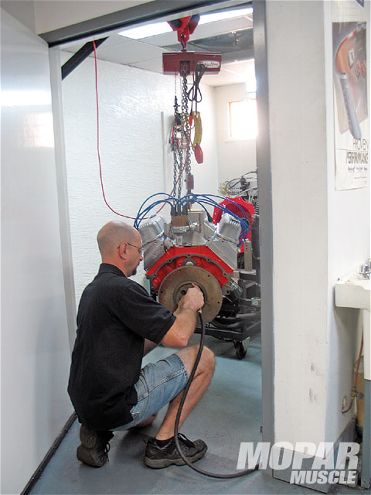 Proving an engine's worth is a lot better if you can physically test it. Saying your engine has 500 hp doesn't mean a thing without the proof, so we hooked up to the Dyno at Automotive Performance Engines in Auburndale, Florida.
Proving an engine's worth is a lot better if you can physically test it. Saying your engine has 500 hp doesn't mean a thing without the proof, so we hooked up to the Dyno at Automotive Performance Engines in Auburndale, Florida.
As in the old days, the parts list is of stuff designed for durability and performance--to an extent. Our only improvement wish would be to add forged pistons to the mix--currently, the new 340 uses a cast piston. Starting from the bottom, the new 340 replacement block (PN P5007552AB) includes the original 340 production casting part number with an M added at the end to identify it as a Mopar Performance 340 block. The block does have a few cosmetic differences from the original 340 block, but it is machined to work with all 340 production components. Special features include high nickel content for added strength (not a thin wall casting), four-bolt main bearing caps on the center three journals, and a standard 340 journal size. It has a thicker webbing and pan rail (like the 340 T/A), a thicker deck surface, and thicker-bore cylinder walls in major/minor thrust directions. The deck height is approximately 9.600 inches. It also requires the use of Mopar PN 05281090BA oil filter, or equivalent. It is not recommended for use with roller tappets, and may require use of a late '70s 318 motor mount on the left side.
The crankshaft is an internally balanced cast piece with the 340's original 3.31-inch stroke. The rods used in the new 340 are forged I-beam units. We were unable to get part numbers for the crankshaft and rods as of this writing. According to Mopar, altogether, the short-block creates a compression ratio of 10.0:1. Definitely within the realm of using your corner gas station Premium fuel.
Sitting on top of the short-block is a pair of LA-style aluminum Commando heads PN P5153849. This part number head uses 2.020/1.600-inch stainless valves. Since these are LA-style heads, shaft mounted stamped-steel rocker arms are used. We know you're wondering what camshaft is used, so here it is: a hydraulic flat tappet stick, PN P4120233 with .508/.508-inch lift, and a duration at .050 inch of .248/.248 degrees. What can we say other than this camshaft has been around for a long time.
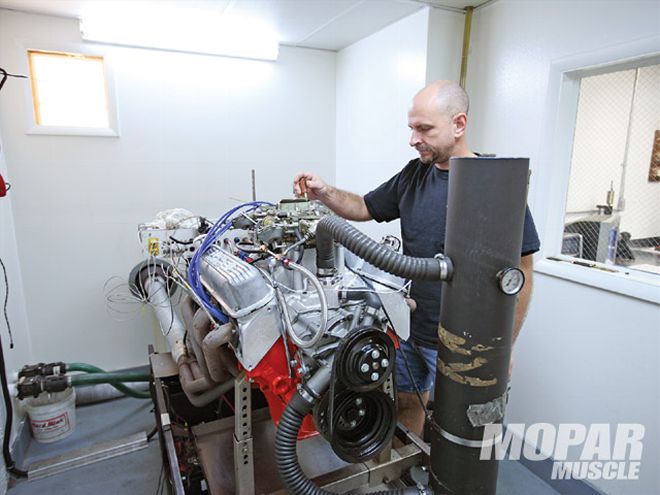 After the second short pull, we decided to play with the carburetor's idle mixture screws a little to see if we could clean up the idle, as it was a little rich. We may have had the Promax jet plates to help tuning, but we should have also gotten the outboard base plates to make the idle adjustments easier. A mistake we won't make again.
After the second short pull, we decided to play with the carburetor's idle mixture screws a little to see if we could clean up the idle, as it was a little rich. We may have had the Promax jet plates to help tuning, but we should have also gotten the outboard base plates to make the idle adjustments easier. A mistake we won't make again.
The visual impact of the original 340 Six Pack was, well, the Six Pack intake and carburetors. Harking back to the previous version, Mopar again decided that history needs to repeat itself, and the Six Pack is again the induction of choice. The intake, PN P4529054, is the same intake used previously, and is ready for you to install the carburetors on top of. Nope, carburetors and linkage are not included but are readily available. Finishing the engine is a stock style oil pan and cast aluminum valve covers. We're glad to see the LA-style heads and valve covers used in this case. Sure, the Magnum-style heads work great, but the 10-bolt valve covers would detract from the vintage look of a true 340 Six Pack.
Well, we told you what's in it, but how does it run? Remember we told you that we proved Mopar was a little off in their horsepower and torque ratings? Well, we'll get back to that. Anyway, after our engine arrived, we contacted Holley because as we said earlier, carburetors are not included. To finish the engine, we got the linkage kit and air filter assembly from YearOne.
As we hooked the engine up to the Dyno, we were concerned about this 340 living up to the reputation of its predecessor. We were still a little concerned after we initially primed the oil system, checked for fuel leaks, and finally fired the engine, as it sounded like a very mild engine. The idle seemed to be fairly smooth, and after some mild tweaking, it idled at around 850 rpm. Like we said, it sounded like a mild, basically stock, small-block. We made some initial pulls to around 5,000 rpm, just to get an idea of how it would act and to get some initial tuning requirements. It sounded like a good engine, and at 5,200 rpm, we ended up with 295.1 hp and 292.1 lb/ft of torque. We weren't sure what to expect after that because 5,200 rpm isn't that far away from what we thought to be peak rpm. We gave it another short pull for good measure and didn't notice much change.
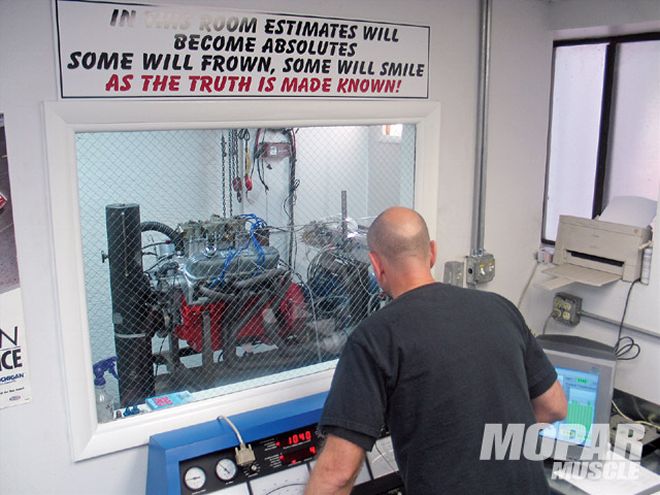 Our initial pulls were short because we wanted to make sure all sounded good before we spun it tight. It sounded good and even a little docile.
Our initial pulls were short because we wanted to make sure all sounded good before we spun it tight. It sounded good and even a little docile.
After the second pull, we decided to spin the engine up to 6,000 rpm and see what happened. We got a decent number--320.4 hp, which was just shy of Mopar's stated number of 330. We decided to add a little timing and see if that helped boost our numbers any. Our initial pulls had the timing set around 32 degrees. This was an initial setting deemed safe to start with. After the fourth pull, though, we bumped the timing up to 34 degrees, and it liked it. We now had more power than Mopar claimed--335.3 hp, and all we did was adjust the timing.
We decided it was time to do some jet changing. Thankfully, before our test session, we installed a set of Promax Carbs' jet plates in the outboard carburetors. Normally, changing fuel delivery in the outboard carburetors required drilling/enlarging the fuel delivery holes in the metering plates. The problem with this is two-fold. First, you physically have to drill the holes. Second, drill the holes too large, and you need to find another metering plate and start over. The Promax plates allow the use of standard Holley carburetor jets, meaning you can change to your heart's content.
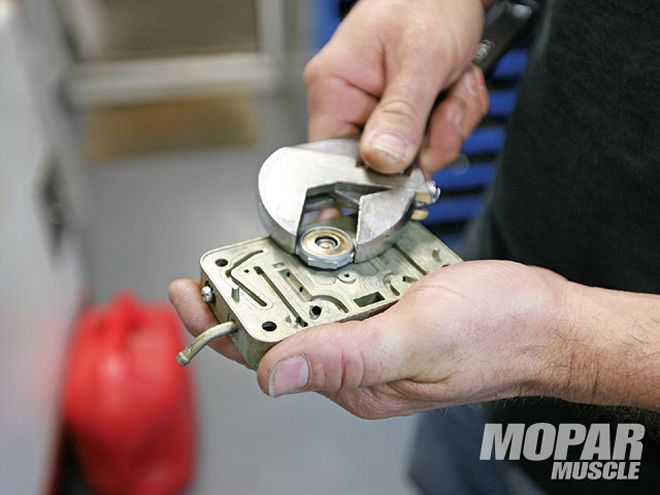 After our first pull to 6,000 rpm, we still felt that the idle was not quite right and decided that the power valve must be the culprit. We changed the center carb's power valve from a 6.5 to a 4.5. After that, we ended up changing it again to a 2.5--man, did that help.
After our first pull to 6,000 rpm, we still felt that the idle was not quite right and decided that the power valve must be the culprit. We changed the center carb's power valve from a 6.5 to a 4.5. After that, we ended up changing it again to a 2.5--man, did that help.
After a few more jet changes, upping the timing to a final setting of 35, and a couple more dyno pulls, we finally hit the end of our power climb--we found all there was to be had from the 340. At the end of the session, our new 340 Six Pack crate engine netted a total of 388.5 hp at 6,800 rpm, and 397.3 lb/ft of torque at 4,200 rpm. Like we said, Mopar wasn't exactly rating this engine correctly. The fact that the tried and true flat-tappet "Purple Shaft" cam willingly spun to 6,800 rpm impressed us. Finally, if we go by Mopar's numbers, we got an additional 58 hp, and little over 63 more lb/ft of torque than they claim. It's always good when you get more than you expect.
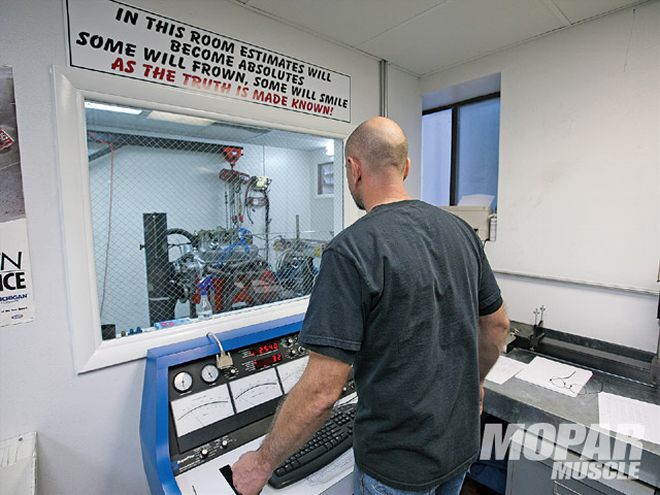 When the screaming was over, the all-new 340 Six Pack engine had lived up to its legacy. It delivered more power than expected and has proven itself as good as--if not better than--its predecessor, and that was a big shoe to fill.
Test - {{{300}}} rpm/secondEngSpdSTPTrqSTPPwrBSFCRPMClb-ftCHplb/hph*3,000341.9195.30.4783,{{{200}}}353.7222.30.4463,400 360.0233.1 0.4603,{{{600}}}361.5247.80.4543,800366.6265.30.4644,000378.7288.40.4664,200393.7314.80.4484,400395.7331.50.4684,600392.1343.40.4754,800383.1350.10.4835,000382.3364.00.479*5,200372.1368.40.4925,400358.4368.50.5045,600349.4372.60.5035,800348.2384.60.4836,000334.9382.60.5156,200313.0369.50.5276,400314.7383.40.5196,600308.1387.10.5096,800300.0388.50.525
*Range: 3,000 rpm - 5,200 rpmAVG: 4,{{{100}}}373.1292.90.470
Our best tune was with the following jets and timingDSPSFront8379Center6765Rear7983Power Valve: 2.5Timing 35 degrees total
When the screaming was over, the all-new 340 Six Pack engine had lived up to its legacy. It delivered more power than expected and has proven itself as good as--if not better than--its predecessor, and that was a big shoe to fill.
Test - {{{300}}} rpm/secondEngSpdSTPTrqSTPPwrBSFCRPMClb-ftCHplb/hph*3,000341.9195.30.4783,{{{200}}}353.7222.30.4463,400 360.0233.1 0.4603,{{{600}}}361.5247.80.4543,800366.6265.30.4644,000378.7288.40.4664,200393.7314.80.4484,400395.7331.50.4684,600392.1343.40.4754,800383.1350.10.4835,000382.3364.00.479*5,200372.1368.40.4925,400358.4368.50.5045,600349.4372.60.5035,800348.2384.60.4836,000334.9382.60.5156,200313.0369.50.5276,400314.7383.40.5196,600308.1387.10.5096,800300.0388.50.525
*Range: 3,000 rpm - 5,200 rpmAVG: 4,{{{100}}}373.1292.90.470
Our best tune was with the following jets and timingDSPSFront8379Center6765Rear7983Power Valve: 2.5Timing 35 degrees total